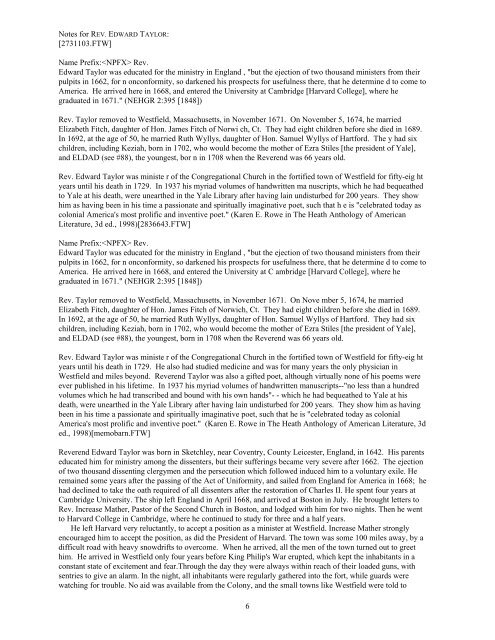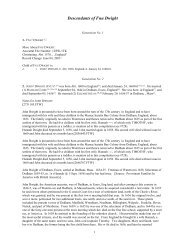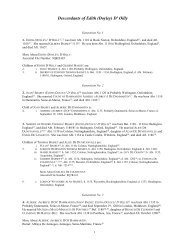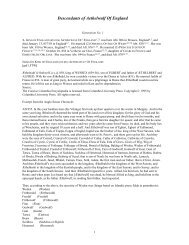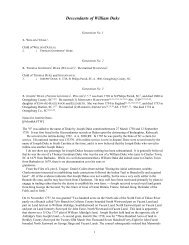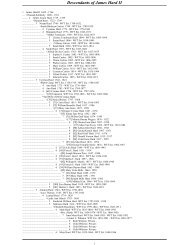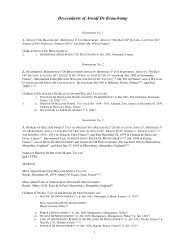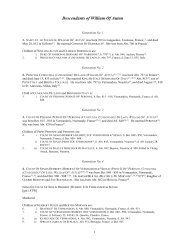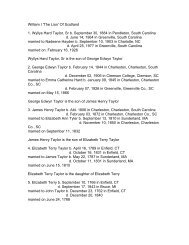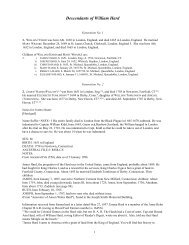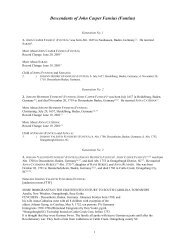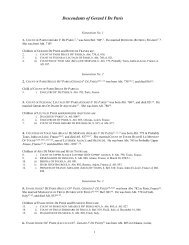Thomas Wyllys 1450.pdf - GBLCreations
Thomas Wyllys 1450.pdf - GBLCreations
Thomas Wyllys 1450.pdf - GBLCreations
Create successful ePaper yourself
Turn your PDF publications into a flip-book with our unique Google optimized e-Paper software.
Notes for REV. EDWARD TAYLOR:<br />
[2731103.FTW]<br />
Name Prefix: Rev.<br />
Edward Taylor was educated for the ministry in England , "but the ejection of two thousand ministers from their<br />
pulpits in 1662, for n onconformity, so darkened his prospects for usefulness there, that he determine d to come to<br />
America. He arrived here in 1668, and entered the University at Cambridge [Harvard College], where he<br />
graduated in 1671." (NEHGR 2:395 [1848])<br />
Rev. Taylor removed to Westfield, Massachusetts, in November 1671. On November 5, 1674, he married<br />
Elizabeth Fitch, daughter of Hon. James Fitch of Norwi ch, Ct. They had eight children before she died in 1689.<br />
In 1692, at the age of 50, he married Ruth <strong>Wyllys</strong>, daughter of Hon. Samuel <strong>Wyllys</strong> of Hartford. The y had six<br />
children, including Keziah, born in 1702, who would become the mother of Ezra Stiles [the president of Yale],<br />
and ELDAD (see #88), the youngest, bor n in 1708 when the Reverend was 66 years old.<br />
Rev. Edward Taylor was ministe r of the Congregational Church in the fortified town of Westfield for fifty-eig ht<br />
years until his death in 1729. In 1937 his myriad volumes of handwritten ma nuscripts, which he had bequeathed<br />
to Yale at his death, were unearthed in the Yale Library after having lain undisturbed for 200 years. They show<br />
him as having been in his time a passionate and spiritually imaginative poet, such that h e is "celebrated today as<br />
colonial America's most prolific and inventive poet." (Karen E. Rowe in The Heath Anthology of American<br />
Literature, 3d ed., 1998)[2836643.FTW]<br />
Name Prefix: Rev.<br />
Edward Taylor was educated for the ministry in England , "but the ejection of two thousand ministers from their<br />
pulpits in 1662, for n onconformity, so darkened his prospects for usefulness there, that he determine d to come to<br />
America. He arrived here in 1668, and entered the University at C ambridge [Harvard College], where he<br />
graduated in 1671." (NEHGR 2:395 [1848])<br />
Rev. Taylor removed to Westfield, Massachusetts, in November 1671. On Nove mber 5, 1674, he married<br />
Elizabeth Fitch, daughter of Hon. James Fitch of Norwich, Ct. They had eight children before she died in 1689.<br />
In 1692, at the age of 50, he married Ruth <strong>Wyllys</strong>, daughter of Hon. Samuel <strong>Wyllys</strong> of Hartford. They had six<br />
children, including Keziah, born in 1702, who would become the mother of Ezra Stiles [the president of Yale],<br />
and ELDAD (see #88), the youngest, born in 1708 when the Reverend was 66 years old.<br />
Rev. Edward Taylor was ministe r of the Congregational Church in the fortified town of Westfield for fifty-eig ht<br />
years until his death in 1729. He also had studied medicine and was for many years the only physician in<br />
Westfield and miles beyond. Reverend Taylor was also a gifted poet, although virtually none of his poems were<br />
ever published in his lifetime. In 1937 his myriad volumes of handwritten manuscripts--"no less than a hundred<br />
volumes which he had transcribed and bound with his own hands"- - which he had bequeathed to Yale at his<br />
death, were unearthed in the Yale Library after having lain undisturbed for 200 years. They show him as having<br />
been in his time a passionate and spiritually imaginative poet, such that he is "celebrated today as colonial<br />
America's most prolific and inventive poet." (Karen E. Rowe in The Heath Anthology of American Literature, 3d<br />
ed., 1998)[memobarn.FTW]<br />
Reverend Edward Taylor was born in Sketchley, near Coventry, County Leicester, England, in 1642. His parents<br />
educated him for ministry among the dissenters, but their sufferings became very severe after 1662. The ejection<br />
of two thousand dissenting clergymen and the persecution which followed induced him to a voluntary exile. He<br />
remained some years after the passing of the Act of Uniformity, and sailed from England for America in 1668; he<br />
had declined to take the oath required of all dissenters after the restoration of Charles II. He spent four years at<br />
Cambridge University. The ship left England in April 1668, and arrived at Boston in July. He brought letters to<br />
Rev. Increase Mather, Pastor of the Second Church in Boston, and lodged with him for two nights. Then he went<br />
to Harvard College in Cambridge, where he continued to study for three and a half years.<br />
He left Harvard very reluctantly, to accept a position as a minister at Westfield. Increase Mather strongly<br />
encouraged him to accept the position, as did the President of Harvard. The town was some 100 miles away, by a<br />
difficult road with heavy snowdrifts to overcome. When he arrived, all the men of the town turned out to greet<br />
him. He arrived in Westfield only four years before King Philip's War erupted, which kept the inhabitants in a<br />
constant state of excitement and fear.Through the day they were always within reach of their loaded guns, with<br />
sentries to give an alarm. In the night, all inhabitants were regularly gathered into the fort, while guards were<br />
watching for trouble. No aid was available from the Colony, and the small towns like Westfield were told to<br />
6


